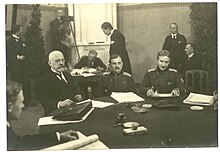Treaty of Tartu (Estonia–Russia)
show This article may be expanded with text translated from the corresponding article in Finnish. (November 2015) Click [show] for important translation instructions. |
 Adolph Joffe (Soviet Russia, left) signing the Treaty of Tartu | |
| Type | Peace treaty |
|---|---|
| Signed | 2 February 1920 |
| Location | Tartu, Estonia |
| Parties | |
The Treaty of Tartu (Estonian: Tartu rahu, lit. 'Tartu peace') is a peace treaty signed on 2 February 1920 between Estonia and the Russian Soviet Federative Socialist Republic, ending the Estonian War of Independence. The terms of the treaty stated: "In consequence of the right of all peoples to self-determination, to the point of seceding completely from the State of which they form part, a right proclaimed by the Socialist and Federal Russian Republic of the Soviets, Russia unreservedly recognizes the independence and sovereignty of the State of Estonia, and renounces voluntarily and forever all sovereign rights possessed by Russia over the Estonian people and territory whether these rights be based on the juridical position that formerly existed in public law, or in the international treaties which, in the sense here indicated, lose their validity in future." Ratifications of the treaty were exchanged in Moscow on 30 March 1920. It was registered in League of Nations Treaty Series on 12 July 1922.[1]
Estonia before the treaty[]
Estonia had been a province of Imperial Russia since 1710, and had been subject to some sort of foreign hegemony since the 13th century.[2] In 1917, three years into World War I, the Russian Empire fell into revolution and civil war. As a part of this larger conflict, the Estonians declared independence from Russia and won their freedom during the Estonian War of Independence. As a symbol of Estonian independence, Yuryev/Dorpat was officially given back its Estonian name, Tartu. The new Communist Russian government acknowledged Estonia's freedom in the 1920 Treaty of Tartu.[3]
Treaty provisions[]
The treaty established the border between Estonia and Russian Soviet Federative Socialist Republic, affirmed the right of Estonian people to return to Estonia and Russian people to return to Russia and required that Estonian movable property evacuated to Russia in World War I be returned to Estonia. Russian Soviet Federative Socialist Republic also agreed to absolve all Russian Imperial debt and to pay Estonia 15 million gold rubles, a share from the gold reserves of the former Russian Empire. Additionally RSFSR agreed to grant concessions to exploit one million hectares of Russian forest land and to build a railway line from the Estonian border to Moscow. In return, Estonia allowed the RSFSR to build a free port at Tallinn or some other harbour and to erect a power station on the Narva River.[4]
Signatories[]

The treaty was signed by Jaan Poska on the Estonian side and Adolf Joffe for Soviet Russia, as well as by other representatives of both parties.[citation needed]
Significance[]
The Tartu Peace Treaty has been regarded as the birth certificate of the Republic of Estonia because it was the first de jure recognition of the state.[5] The treaty was also of utmost importance to the diplomatically isolated Soviet Russia, with Lenin expressing satisfaction with the treaty as "an incomparable victory over Western imperialism".[4] Some members of the Entente opposed the treaty with the intention to keep Soviet Russia in international isolation.[citation needed]
Aftermath[]
After the signing, Soviet Russia did not fulfill several points of the treaty. For example, the museological collections of the University of Tartu have not been returned to this day from Voronezh[6] and the migration of Estonians was obstructed.[7]
Estonia was later invaded, occupied and annexed by the USSR during World War II, following the Molotov-Ribbentrop Agreement. That secret treaty – between Nazi Germany and the USSR – defined the borders of Soviet and German spheres of influence across the territories of Poland, Lithuania, Latvia, Estonia, and Finland. The three Baltic states were then annexed as constituent republics. The last of the Russian military finally withdrew in 1994.[8]
The Estonia-Russia border today leaves some land granted to Estonia by the Treaty of Tartu under Russian control.[9]
See also[]
| Wikisource has original text related to this article: |
| Wikimedia Commons has media related to Treaty of Tartu (Russo–Estonian treaty). |
References[]
- ^ League of Nations Treaty Series, vol. 11, pp. 30–71.
- ^ Remembering the Tartu Peace Treaty.
- ^ "Introduction to Tartu".
- ^ Jump up to: a b Georg von Rauch, The Baltic States: The Years of Independence 1917–1940, Hurst & Co, 1974, p. 73
- ^ Frucht, Richard (2005). Eastern Europe. ABC-CLIO. p. 76. ISBN 1-57607-800-0.
- ^ "UT ART MUSEUM PRESENTED CATALOGUE OF UNIVERSITY ART COLLECTION HELD AT VORONEZH, RUSSIA – University of Tartu". 7 February 2012. Archived from the original on 7 February 2012.
- ^ Ülo Kaevats et al. 1996. Eesti Entsüklopeedia 9. Tallinn: Eesti Entsüklopeediakirjastus, ISBN 5-89900-047-3
- ^ 25 years since the withdrawal of Russian troops from Estonia Estonian Ministry of Foreign Affairs. 31 August 2019.
- ^ "Россия отозвала подписи под договорами о границе с Эстонией" [Russia withdraws signatures on border treaties with Estonia]. Российская газета (in Russian). 1 September 2005.
External links[]
- Estonian War of Independence
- Peace treaties of Estonia
- Peace treaties of Russia
- 1920 in Estonia
- Estonia–Russia relations
- Estonia–Russia border
- Interwar-period treaties
- Treaties concluded in 1920
- Treaties entered into force in 1920
- History of Tartu
- Treaties of the Russian Soviet Federative Socialist Republic
- February 1920 events
- Peace treaties of the Soviet Union